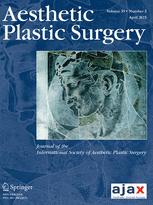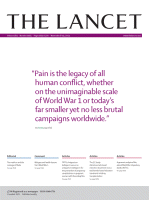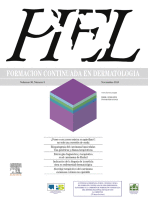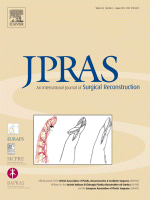Freshwater, M. F.
Journal of Plastic, Reconstructive & Aesthetic Surgery. 2011; (64) 1: 17-26
 The second decade of the 20th century saw the publication of two landmark books – John Staige Davis’ Plastic Surgery its Principles and Practice published in Philadelphia in 1919 and Major Harold Gillies’ Plastic Surgery of the Face published in the United Kingdom early 1920. The aim of this paper is to compare the books critically as scholarly achievements in their time and note their present day relevance.
The second decade of the 20th century saw the publication of two landmark books – John Staige Davis’ Plastic Surgery its Principles and Practice published in Philadelphia in 1919 and Major Harold Gillies’ Plastic Surgery of the Face published in the United Kingdom early 1920. The aim of this paper is to compare the books critically as scholarly achievements in their time and note their present day relevance.
 Según el Diccionario de la Real Academia Española (DRAE) un anglicismo es un vocablo o giro de la lengua inglesa empleado en otra. En el caso de nuestro idioma no es difícil hallar ejemplos ya que nuestras conversaciones diarias se encuentran plagadas de este tipo de términos: pin, panty, penalti.
Según el Diccionario de la Real Academia Española (DRAE) un anglicismo es un vocablo o giro de la lengua inglesa empleado en otra. En el caso de nuestro idioma no es difícil hallar ejemplos ya que nuestras conversaciones diarias se encuentran plagadas de este tipo de términos: pin, panty, penalti. 
 The roots of science and art of plastic surgery are very antique. Anatomy, drawing, painting, and sculpting have been very important to the surgery and medicine development over the centuries. Artistic skills besides shape, volume, and lines perception can be a practical aid to the plastic surgeons’ daily work. An overview about the interactions between art and plastic surgery is presented, with a few applications to rhinoplasty, cleft lip, and other reconstructive plastic surgeries.
The roots of science and art of plastic surgery are very antique. Anatomy, drawing, painting, and sculpting have been very important to the surgery and medicine development over the centuries. Artistic skills besides shape, volume, and lines perception can be a practical aid to the plastic surgeons’ daily work. An overview about the interactions between art and plastic surgery is presented, with a few applications to rhinoplasty, cleft lip, and other reconstructive plastic surgeries. The Royal College of Surgeons’ new exhibition, War, Art and Surgery , brings together two radically different yet complementary responses to war. Henry Tonks’ harrowing and highly personal images of soldiers treated by the plastic surgeon Harold Gillies during the First World War are counterbalanced by Julia Midgley’s contemporary emphasis on recovery and rehabilitation after conflict in Afghanistan and Iraq.
The Royal College of Surgeons’ new exhibition, War, Art and Surgery , brings together two radically different yet complementary responses to war. Henry Tonks’ harrowing and highly personal images of soldiers treated by the plastic surgeon Harold Gillies during the First World War are counterbalanced by Julia Midgley’s contemporary emphasis on recovery and rehabilitation after conflict in Afghanistan and Iraq. La música ha acompañado a la medicina desde los albores de nuestra existencia. Los papiros de Kahum, en el Antiguo Egipto, fueron el primer testimonio que hizo referencia a los potenciales beneficios sobre la salud que aportaba la música . Posteriormente, personalidades griegas tan importantes como Herófilo o Pitágoras establecieron que la música suponía un vínculo entre el alma y la armonía del universo, y contribuía de muy diversas formas a la salud y bienestar de los seres humanos.
La música ha acompañado a la medicina desde los albores de nuestra existencia. Los papiros de Kahum, en el Antiguo Egipto, fueron el primer testimonio que hizo referencia a los potenciales beneficios sobre la salud que aportaba la música . Posteriormente, personalidades griegas tan importantes como Herófilo o Pitágoras establecieron que la música suponía un vínculo entre el alma y la armonía del universo, y contribuía de muy diversas formas a la salud y bienestar de los seres humanos. The latest iteration in the Sherlock Holmes movies arrived in America on Christmas Day. Digital effects allowed its director, Guy Ritchie, to have slow motion sequences that showed how Holmes used his senses to deduce facts about other characters. Holmes was a fictional detective, but we plastic surgeons are fortunate to have been taught Gillies’ principle ‘Observation is the basis of surgical diagnosis.’ This was Gillies’ first principle and the basis of his others. He believed that without a proper diagnosis surgical disaster loomed and went so far as to say, ‘Mistakes in diagnosis due to inadequate examination are perhaps the commonest cause of indifferent treatment’.
The latest iteration in the Sherlock Holmes movies arrived in America on Christmas Day. Digital effects allowed its director, Guy Ritchie, to have slow motion sequences that showed how Holmes used his senses to deduce facts about other characters. Holmes was a fictional detective, but we plastic surgeons are fortunate to have been taught Gillies’ principle ‘Observation is the basis of surgical diagnosis.’ This was Gillies’ first principle and the basis of his others. He believed that without a proper diagnosis surgical disaster loomed and went so far as to say, ‘Mistakes in diagnosis due to inadequate examination are perhaps the commonest cause of indifferent treatment’.







 Sitio web publicado el
Sitio web publicado el
Los lectores comentan